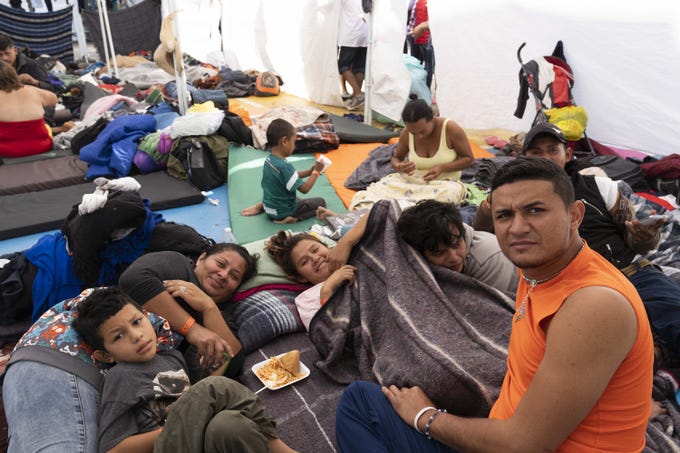
Health experts race to plan for the potential arrival of COVID-19 in a makeshift refugee camp on the US-Mexico border.
Fears over Coronavirus Grip Migrant Camps on US-Mexico Border
MATAMOROS, Mexico (March 12, 2020) — Doctors working at a makeshift migrant and refugee encampment along the US-Mexico border are treating the potential arrival of the novel coronavirus, now declared a worldwide pandemic, as a certainty, not a possibility.
A doctor at the camp in Matamoros, Mexico, said when COVID-19 arrives here, it will be “catastrophic”, and people will die.
About 2,500 migrants and asylum seekers live in the encampment, which consists of thousands of tents.
Many have lived in the camp for months as they wait out their asylum cases in the US under the Trump administration’s Migrant Protection Protocols programme or the “Remain in Mexico” policy as it is informally called.
Mexico and Texas, the US state bordering Matamoros, have confirmed cases of the novel coronavirus.
US President Donald Trump said earlier this month that he was “very strongly” considering closing the southern border due to COVID-19, which would have prevented many volunteer health workers from crossing the border daily to work in the camp. But Trump later reversed course, saying the border would remain open.
“Globally, we’re reaching the point where containment is no longer a viable strategy,” said Sam Bishop, Matamoros project coordinator for Global Response Management, which runs the camp’s only clinic.
“It’s gotta be more about making sure we’re caring for the people who are most at risk, and that’s the elderly population, patients with comorbidities, hypertension, heart disease, diabetes, respiratory disease, because that’s really where the high mortality cases are,” he told Al Jazeera.
Racing to Plan, Risk Heightened by Volunteers
The camp’s clinic is a cluster of temporary buildings and a trailer arranged around a carpeted open-air waiting area. It is staffed by volunteer doctors, nurses, pharmacists and a gynaecologist. Bishop said the most common ailments they see are headaches, upper respiratory complaints and gastrointestinal illnesses.
Coronavirus is currently more prevalent in the US than in Mexico, according to official data. The biggest risk currently in the camp comes from volunteers crossing the border from the US who might be carrying the virus and not realise it, Bishop said.
Global Response Management has instructed volunteers who are higher risk for bringing the virus over the border to not come to the camp. This includes volunteers who have worked at a hospital that is dealing with coronavirus, have travelled to Europe or Asia in the last month or have a fever, cough or flu-like symptoms.
Bishop said the camp is already seeing a drop in the number of healthcare volunteers because the hospitals where they work are cancelling their travel plans so they can help fight coronavirus at home.

About 2,500 migrants and asylum seekers live in a camp in Matamoros, Mexico. [Daniel Becerril/Reuters]
The clinic is now racing to plan for the possible arrival of COVID-19.
“We have been having conversations about it for several weeks now, and there’s a lot of challenges for it in our environment in particular,” Bishop said.
The clinic does not have the ability to test for the coronavirus, so it is impossible to positively identify cases. With everyone living in tents, there is also no way to isolate patients.
“A lot of the concerns are around the pretty large space requirement,” Bishop said. “In order to really keep a patient isolated, you need a lot of space around them. Coronavirus is really resource-intensive” he added.
Bishop said Global Response Management will not forcibly quarantine anyone, and an isolation programme will not be successful in a crowded refugee camp, but they do want to build a larger tent at the south end of the camp away from the majority of people to act as an intensive care unit for severe cases.
They are also considering a “reverse quarantine”, where people who are most at risk could go to try to avoid the virus.
The clinic does not have the capabilities to intubate patients or hook them up to ventilators.
They are working with the local government to come up with a plan. “We want to collaborate with the in-place healthcare network in Mexico as much as possible on this,” Bishop said.
‘If it’s going to happen, it’s going to happen’
For serious medical emergencies, the clinic refers patients to local hospitals. But Bishop said many fear to Matamoros hospitals because there is a lot of discrimination against asylum seekers.
“We are worried about it, but we’re ready,” said Dairon Elisondo Rojas.
An asylum seeker himself, Rojas was the first doctor to start working in the camp. When COVID-19 reaches the camp, he said it would be “catastrophic” and fatal.
Healthcare workers are giving free flu shots to everyone in the camp so that when people show symptoms of respiratory illness, they can more easily rule out the flu, Rojas said. Each country represented in the camp has its own representative, who sends newly arrived asylum seekers to the medical area to get the flu vaccination.
The clinic plans to post information about COVID-19 around the camp, and will hand out pamphlets and hold information sessions.
Sanitation in the camp has improved in recent months; there are handwashing stations next to the portable washrooms, and clean drinking water is now available.
A family in the camp said they were not worried about COVID-19.
“If the sickness is going to happen, it’s going to happen,” said one asylum seeker who is fleeing violence in Mexico. They expect to get sick no matter where they are, the asylum seeker said.
More:
§ US Supreme Court allows ‘Remain in Mexico’ to stay in place
§ A refugee camp grows on the US-Mexico border
§ Coronavirus: What is a pandemic and how will things change?
Posted in accordance with Title 17, Section 107, US Code, for noncommercial, educational purposes.